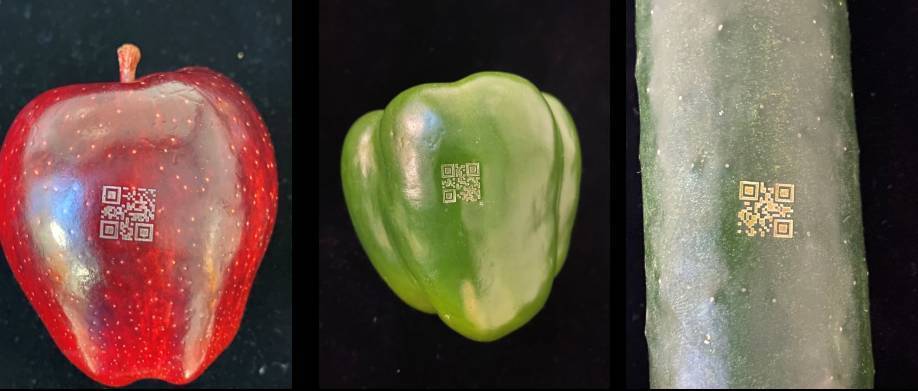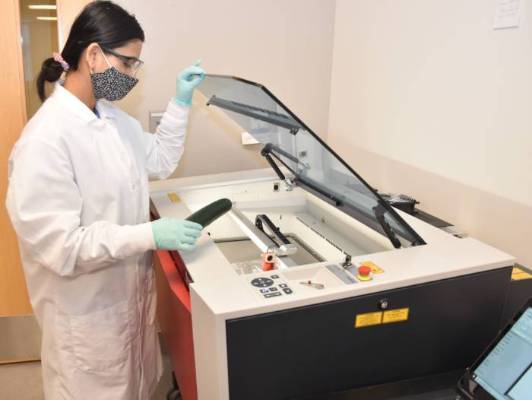Passion for produce innovation
The small plastic stickers found on fresh produce such as apples, bananas, cucumbers and bell peppers are synonymous with grocery shopping. What if those stickers could one day be a thing of the past?
A team of researchers at Kansas State University Olathe is exploring that possibility with a project that was supported through the K-State Global Food Systems Seed Grant Program.
The Global Food System Initiative, or GFS, at K-State highlights graduate students and their contributions to these Seed Grant projects.
Durga Khadka is a second-year master’s student at K-State Olathe pursuing a Master of Science in horticulture with an emphasis on urban food systems. She joined the GFS staff for a conversation to share more about herself and her research.
Khadka is originally from Kathmandu, Nepal and received two degrees in her home country — a Bachelor of Public Health from Purbanchal University and a Master of Arts in sociology from Tribhuvan University.
After graduating, she spent five years working for the Food and Agriculture Organization of the United Nations in the Global Agriculture and Food Security Project, as well as some other non-profit organizations before coming to K-State Olathe for her second master’s degree.
Classes about food science and nutrition inspired an interest in pursuing a career in the food safety industry — an interest that grew with her work experience on agriculture and food security projects with the U.N.
K-State was not unfamiliar to Khadka. Her husband, Manoj Chhetri, obtained his doctorate in horticulture from K-State in 2021. They are both first-generation students and are happy parents of a five-year-old son. One of her hobbies is gardening because she enjoys growing her own fresh produce and harvesting it for a meal.
“I’m quite passionate about food safety to improve the public’s health. I would like to put my knowledge and skills into the food and agriculture industry to ensure food safety from the farm to the fork,” Khadka said.
 The goal of the project is to discover a safe and successful alternative for the plastic price look-up, or PLU, stickers typically used on fresh produce. To do this, the team is experimenting with using a laser printer to engrave quick response, or QR, code labels onto produce items including apples, cucumbers and green bell peppers.
The goal of the project is to discover a safe and successful alternative for the plastic price look-up, or PLU, stickers typically used on fresh produce. To do this, the team is experimenting with using a laser printer to engrave quick response, or QR, code labels onto produce items including apples, cucumbers and green bell peppers.
Why is an alternative necessary? Khadka brought up two problems with PLU stickers.
First, the stickers can detach from produce at any time in the supply chain which eliminates the item’s traceability. Second, the stickers pose environmental contamination due to the use of plastic and glue on them. France recently banned noncompostable stickers on produce. This has great implications because the U.S. is one of the largest exporters of sweet potatoes and grapefruit to France.
The new technology of laser-engraving produce with QR codes solves both of these problems because the code is permanent as well as environmentally friendly.
Another advantage to the QR code is its ability to provide bonus information beyond the price of the produce item. Khadka says tracking food shortages, preventing and managing disease outbreaks linked to fruits and vegetables, and providing the nutritional value of an item are a few of the extra pieces of information a QR code could provide.
Some initial concerns with this technology which the team investigated were how it would affect weight loss, physical appearance or freshness, and if the exposed surface would become more susceptible to microbial contamination.
One of Khadka’s roles for the project was collecting data on the postharvest quality of the produce. The results she found in this area were positive.
“The research shows that this technology did not affect any postharvest quality or shelf life. It also did not increase the susceptibility of microbial contamination on the laser label produce in comparison to the control,” she said.
Consumer acceptability is also a significant factor with this new technology.
The team conducted a survey of 75 people, ages 18 to 64 years old. There were mixed responses and several questions such as, whether the produce - with the QR code - was washable and if it is safe to eat. Khadka said that the laser-engraved QR code is washable and cannot be removed and the produce is safe to eat because it uses no chemicals or ink.

The need to further inform and educate the public about this technology became apparent to the team, but they found that consumers are mostly excited about its potential.
Khadka says the next step is reducing the time it takes to engrave the QR code onto the produce, which is currently about 15 seconds. The laser engraving machine is also quite expensive right now. Once that is resolved more steps towards commercialization of the technology can begin.
In all, Khadka is optimistic and excited about the future implementation of this novice technology.
“We concluded that the overall finding of the research is that we can move forward with this technology as a safe alternative to the PLU stickers,” Khadka said. “Don’t be surprised when you go to the grocery store and see the QR code printed on your fresh produce sometime in the near future.”
Read more about this research in the spring 2022 issue of Seek magazine. You can also watch the principal investigators, Eleni Pliakoni and Manreet Bhullar, present their research by clicking Pliakoni's name under the FY 2022 dropdown.
